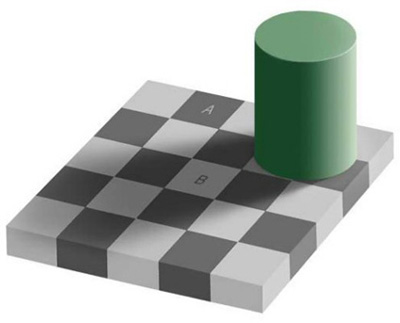What are Optical Illusions?
It is difficult to admit that the eye betrays us. However, anyone who has ever encountered some form of optical illusion can attest to the fact that what we see isn't always what's there, and yet there is often more to an image than meets the eye.
An optical illusion is a visually perceived image that, at least in common sense terms, is deceptive or misleading. The information gathered by the eye is processed by the brain to give, on the face of it, a "percept" that does not tally with a physical measurement of the stimulus source. For example, in the image below, you will probably find it hard to believe that squares A and B are actually the same shade of gray. However, if you screen cap or save this image and open it in your image editor, "select" square A and then pull it next to square B, you will see that they are in fact the exact same color! Almost impossible to perceive at first glance though.

A conventional assumption is that there are physiological illusions that occur naturally and cognitive illusions that can be demonstrated by specific visual tricks that say something more basic about how human perceptual systems work.
Physiological illusions, such as the afterimages following bright lights or adapting stimuli of excessively longer alternating patterns (contingent perceptual aftereffect), are presumed to be the effects on the eyes or brain of excessive stimulation of a specific type - brightness, tilt, color, movement, and so on. The theory is that stimuli have individual dedicated neural paths in the early stages of visual processing, and that repetitive stimulation of only one or a few channels causes a physiological imbalance that alters perception.
Cognitive illusions are assumed to arise by interaction with assumptions about the world, leading to "unconscious inferences", an idea first suggested in the 19th century by Hermann Helmholtz. Cognitive illusions are commonly divided into ambiguous illusions, distorting illusions, paradox illusions, or fiction illusions (hallucinations).